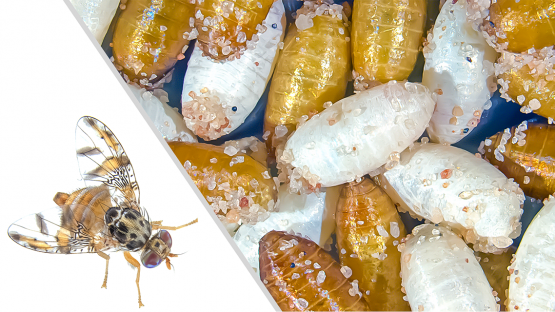Fruit flies can be a nuisance in one’s kitchen. More importantly, across farmlands around the world, these highly destructive pests can wreak havoc among fruit and vegetable production. Nuclear science and technology have helped to suppress such pests in an environment-friendly manner with the sterile insect technique (SIT). The IAEA, in cooperation with the Food and Agriculture Organization of the United Nations (FAO), has helped countries implement SIT, in which irradiation is used to sterilize insect pests and thereby suppress or eradicate their populations over time.
It is typically female insects that damage fruits by laying eggs in them. SIT, during which hundreds of millions of insects are reared and released, needs to focus on the male insect, which do not destroy produce or cause economic damage. Therefore, SIT is most efficient when males can be separated from females before irradiation. “The efficiency and cost effectiveness of SIT is enhanced by male-only releases, which are usually achieved through separation methods, such as genetic sexing strains (GSS),” said Konstantinos Bourtzis, a molecular biologist at the Joint FAO/IAEA Centre of Nuclear Techniques in Food and Agriculture and co-author of a paper published earlier this year in Nature Communications. GSS enables the separation of large numbers of insects according to sex earlier in the insects’ development cycle (see Genetic sexing for more efficient SIT application). “One of the costliest components of SIT is rearing,” Bourtzis continued. “Why rear females if we do not need them for releases?”
The GSS requires a selectable gene marker, a specific gene that is linked to the sex of the insect and allows the separation of males from females. One selectable marker that has been used for the construction of GSS in some of the most destructive tephritid pest species – Ceratitis capitata (Mediterranean fruit fly), Bactrocera dorsalis (Oriental fruit fly) and Zeugodacus cucurbitae (melon fly) – is the colour of pupae. Pupae are insects in immature form between larvae and adults.
In a recent study by experts at the Joint FAO/IAEA Centre, in collaboration with several research institutions, scientists isolated the white pupae gene responsible for the colour of pupae in tephritids. “The original pupae colour is brown, while mutations in the gene can change the colour from brown to white. This allows the links – the brown pupae colour to males and the white pupae colour to females – and the construction of GSS. Interestingly, the great majority of the insects tested had the white pupae gene, including insect species of SIT importance,” Bourtzis said. The isolation of the white pupae gene, in combination with its presence in most insect species, will allow for the faster development of mutant strains that could be used for GSS. As a proof of principle, new strains with the white pupae mutant gene were developed for the Mediterranean fruit fly and the Queensland fruit fly, Bactrocera tryoni.
“It is now possible to create such colour variants in new species in a targeted manner. This can be conducted effectively through minimally invasive genome editing and without introducing any foreign genes,” said Marc F. Schetelig of the Institute for Insect Biotechnology at Justus-Liebig-University Giessen and co-author of the study. “Bringing this system to new species will expand the reach of SIT programmes and allow for improved and successful area-wide insect pest management.”






